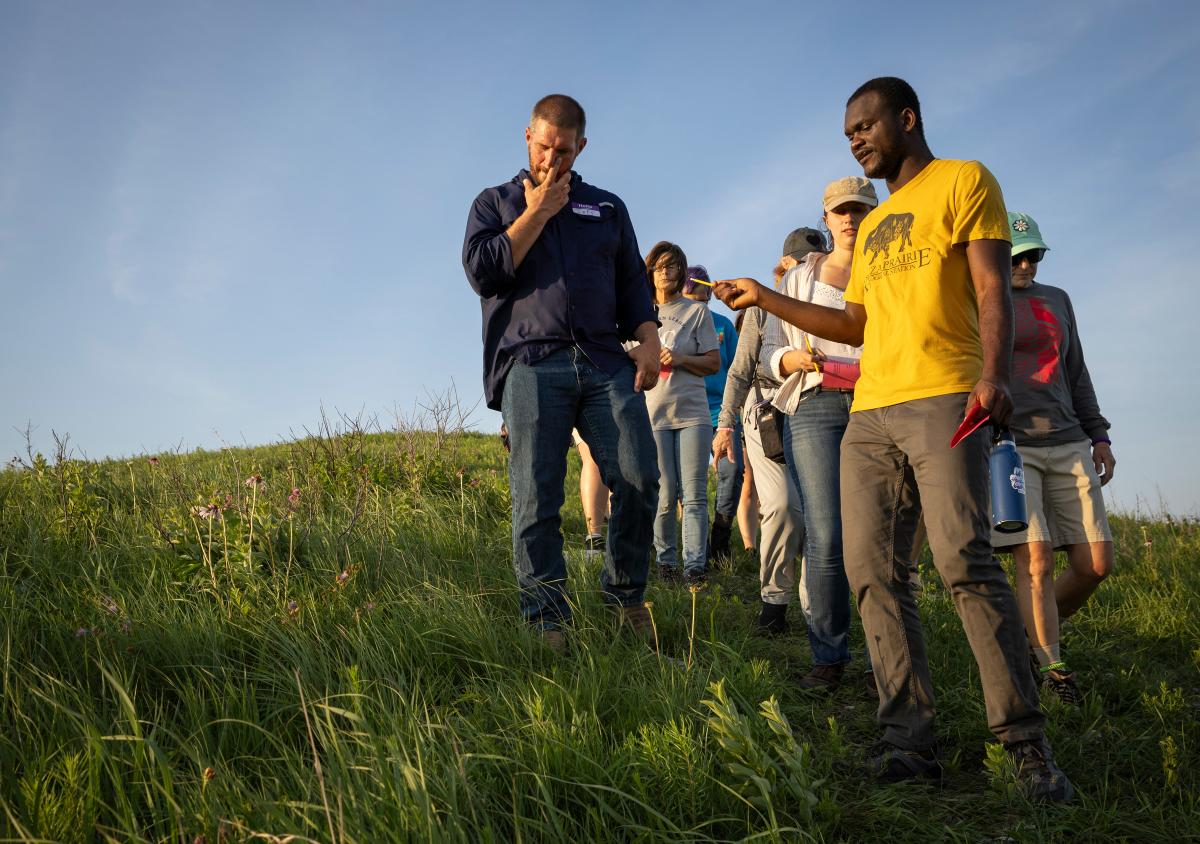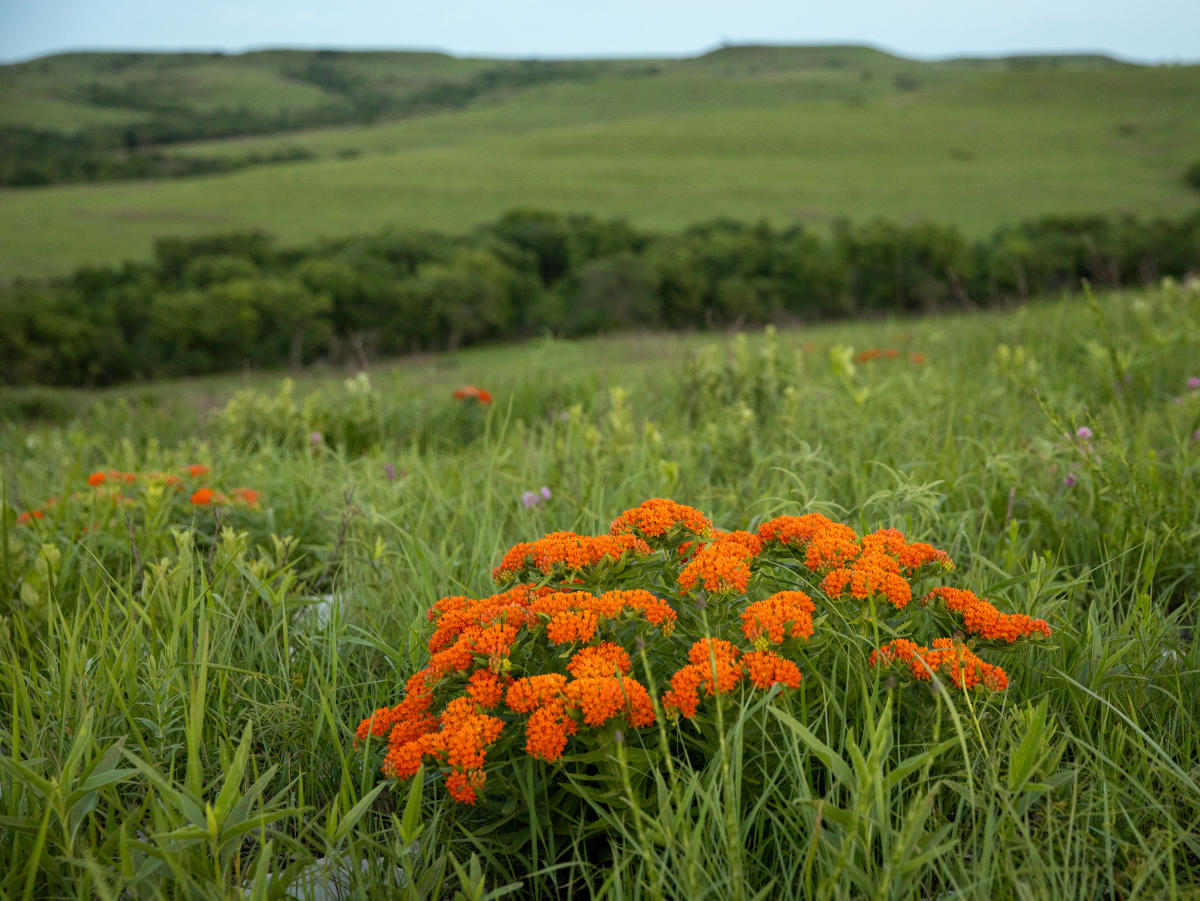 Photography by Amy Meng
Photography by Amy Meng
Treks through the Flint Hills let visitors reconnect with nature
Without a doubt, the best artist in Kansas is Mother Nature. Her palette is bright and bold with eye-popping displays of red butterfly milkweed, bursts of blue wild indigo and glorious arrays of Indian blanket flowers. The Flint Hills showcases how the prairie once stretched across the Great Plains. Moreover, this complex ecosystem plays an important role in biodiversity.
“The Great Plains once was a vast grassland extending from Oklahoma to Canada,” says Krista Dahlinger, a geologist, amateur botanist from Wichita and secretary of the Kansas Native Plant Society. “Most of the grasslands have been converted to farmland or agricultural use. And ranchers only want grass, so they will spray out everything they consider a broadleaf weed.”
Only 4% remains of the tallgrass prairie that once covered 170 million acres of North America, according to the National Park Service. Because of farming, urban sprawl and other consequences of westward expansion, much of it has been lost forever. The largest surviving portion is found in the Tallgrass Prairie National Preserve near Strong City.
The Power of Preservation
Located in the heart of the Flint Hills, the Tallgrass Prairie National Preserve was established on November 12, 1996. Spanning nearly 11,000 acres, this protected piece of land is cooperatively managed through public-private partnership between the National Park Service and the Nature Conservancy.

The preserve features rolling hills covered in four tallgrasses that can reach 6 to 8 feet, given the right conditions: big bluestem, Indian grass, little bluestem and switchgrass. Native grasses are outnumbered only by the wildflowers that paint the prairie. Wildflowers account for 80% of the preserve’s biodiversity, according to the National Park Service. However, they cover only 20% of the prairie; grass species cover the remaining 80%.
This living landscape also supports a variety of wildlife, including bison that freely roam the preserve, thanks to a Bison Conservation Initiative in 2008. In an effort to increase the biodiversity of the preserve, 13 bison were airlifted from Wind Cave National Park in South Dakota to the Flint Hills. Today, the preserve is home to about 100 bison.
A Step in the Right Direction
To walk among the tall grasses, smell the wildflowers, or even catch a glimpse of bison, follow one of the preserve’s 40 miles of hiking trails or guided tours. “If we take the time to visit the Flint Hills, we can find inspiration in every season,” says Annie Wilson, an educator, rancher and singer-songwriter near Elmdale. “The secret is to get out of the car and find a trail.”
In the spring, Wilson suggests walking along the scenic ridgetops, rocky hillsides or open meadows. Spring is also when the prairies are burned. “Even the burned prairie is a wonderland of geology, revealing ancient ‘bones’ of the Flint Hills in limestone ridges, outcrops and fascinating displays of fossils from the early inland sea,” Wilson says. “Within just a few days after the fires, we can witness a resurrection as the lifeless, charred soil turns into a luminous green blanket stretching over the hills.”

In the fall, Mother Nature’s artwork is just as stunning as it was in the spring. “Prairie soils reveal a bounty so glorious, the prairie seems to have almost outgrown itself,” Wilson says. “Enormous, intricate seedheads crown the waist-high trunks of tallgrass, so heavy they bend under their own weight, spilling out over trails and large rocks.”
For a deeper understanding of the prairie ecosystem, consider attending any of the Flint Hills’ nature talks, walks or tours. For example, the Friends of the Konza Prairie (keep.konza.k-state.edu/fokp) offers an annual Wildflower Walk in June. Both the Kansas Native Plant Society (kansasnativeplantsociety.org) and Kansas Land Trust (klt.org) offer seasonal events that provide a closer look at the unique beauty of the area. Experts, including authors, conservation coordinators and scientists from the Kansas Biological Survey offer guided tours and share their wisdom. Program organizers often require RSVPs to gauge interest, so be sure to respond early to event announcements.
Dahlinger also suggests joining Kansas conservation groups such as the Friends of the Konza Prairie or the Kansas Native Plant Society, which periodically hosts field trips. The Kansas Wildlife Federation (kansaswildlifefederation.org), Kansas Land Trust (klt.org), The Nature Conservancy (nature.org) and the Northern Flint Hills Audubon Society (nfhas.org) are also excellent resources for discovering opportunities for outdoor education and exploration.
For some of the best wildflower displays in any season, visit the rural county lakes within the Flint Hills. A Pocket Guide to Kansas Flint Hills Wildflowers and Grasses (Friends of the Great Plains Nature Center) lists more than 50 easily identifiable plants. Thanks to guides like this, even novice explorers can point out some foliage.
Regardless of your skill or knowledge, there’s something to appreciate in the open air and expanses of the prairie for those willing to make the trek.

Prairie Preserve
The Tallgrass Prairie National Preserve is open year-round except during scheduled burns, which begin in late February and continue through mid-April, according to the Kansas Fire Service. These prescribed burns maintain the health of the grasslands and reduce the risk of wildfire. Always check the park’s website for the most current information.
Hiking trails consist of old gravel ranch roads and mowed paths. Expect to see grasses up to 6 inches in the spring; they’ll grow all summer and reach maximum heights in late September to early October. nps.gov/tapr/index.htm
Konza Prairie Wildflower Walks
The Friends of the Konza Prairie host an annual Wildflower Walk at the Konza Prairie Biological Station. Guides point out native plants and answer questions during this 1.5-mile hike along the Butterfly Hill Trail. The Konza prairie is a tallgrass prairie preserve located in the Flint Hills. The next guided tour will be June 1 at 6:30 p.m. Call 785.587.0381 for more information.




